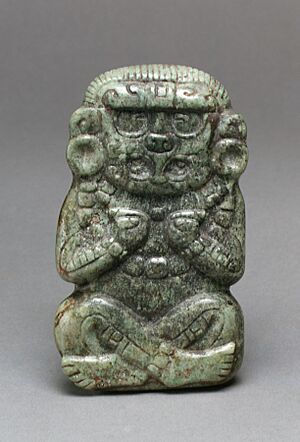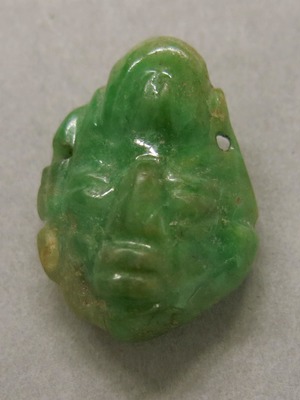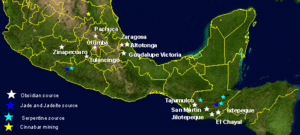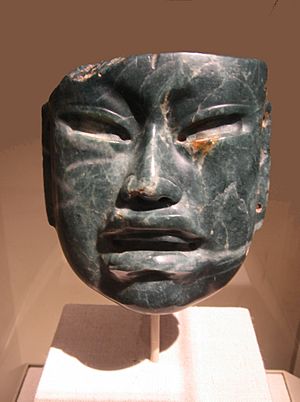Jade use in Mesoamerica facts for kids
Jade was very important in ancient Mesoamerica. Cultures like the Olmec and Maya valued it highly. They used it for special ceremonies and to show their beliefs. Jade was rare and precious, which made it even more special. For a long time, people thought the only place to find jadeite in this region was the Motagua River valley in Guatemala.
Jade is also incredibly strong. This made it perfect for ancient Mesoamerican tools and art. People carved it into beautiful ornamental stones. They also used it to write glyphs, make figurines, weapons, and other objects. Many jade items from later civilizations look like they were cut from simple jade axes. This suggests that early jade trade might have started with useful tools.
Contents
What is Jade?
In simple terms, "jade" refers to two different minerals. These are nephrite and jadeite. Nephrite is rich in calcium and magnesium. Jadeite has a lot of sodium and aluminum. Some people mistakenly believe nephrite doesn't exist in Mesoamerica. However, the same area in the Motagua River Valley that has jadeite also has nephrite. Ancient artists just preferred working with jadeite.
When people talk about "jade" objects from Mesoamerica, they usually mean jadeite. But sometimes, they might also be talking about other hard, green stones. These include stones like albitite, omphacite, chrysoprase, and quartzite.
Why Jade Has Different Colors
The color of jade changes because of tiny amounts of other elements inside it. These are called trace elements. For example, "Olmec Blue" jade is a pale, icy blue. Its color comes from iron and titanium. Green jade, which is more common, gets its color from different amounts of sodium, aluminum, iron, and chromium. Jade can also be very clear or completely opaque. This means you can see through some pieces, but not others.
Where Was Jade Found in Mesoamerica?

After the Maya civilization declined, the exact locations of their jade sources were lost. The search for these sources began in 1799. This was when Alexander von Humboldt started his geological research in the New World. He wanted to know if jade tools found in Europe came from the same places as those in Mesoamerica. They did not.
Discovering Ancient Jade Mines
The first discovery of jade quarries still in their original place happened in 1974. Archeologist Mary Lou Ridinger made this important find. Before her discovery, experts weren't sure where the Maya got their jade. Even after her find, there was some debate. But now, her discovery is accepted as the first clear proof of the Maya's jade sources. Since then, Ridinger has found many new types of Central American jadeite. These include lilac jade and jadeite with tiny pieces of pyrite inside.
From 1974 to 1996, the only known jadeite source was the lowland Motagua River valley. But between 1977 and 2000, the Mesoamerican Jade Project found more. They found the long-lost "Olmec Blue" mines. This discovery was published in 2001. They also studied ancient Maya mines in the mountains near the Motagua River.
After Hurricane Mitch in 1998, heavy rains uncovered blue jade stones. These stones were traced up a river called the Rio Tambor. They led to huge deposits of beautiful "Olmec Blue" jadeite. These deposits were high up in the mountains, in the Jalapa province. Scientists found that this blue jade was much older than the green jade sold to tourists. Other jade sources were found higher up near the Rio Blanco. Some ancient mining sites there were connected by stone paths.
It's interesting that the best "Olmec Blue" jade source is not in the Motagua Valley itself. It's about 50 kilometers southwest of Copán. Since the Motagua River forms part of Guatemala's border with Honduras, Honduras might also have jade. This rediscovered "Olmec" jade was traded far and wide. It reached places like the Valley of Mexico and Costa Rica.
Some experts thought there might be another source in Mexico, but none has been found. However, new research shows that similar jade deposits exist in Cuba and Hispaniola. People from the Taino and Carib cultures used this jade. Jade tools from these Caribbean islands have been found as far east as Antigua. It's possible that these jade deposits also extend into Chiapas, Mexico.
One of the Bay Islands, called Barbaretta, is also rich in green and blue jadeite. There's even a place called Jade Beach. It has cliffs of jadeite, and the beach is covered with smooth, polished jade stones.
How Ancient People Used Jade
Jade in Art
Ancient people shaped jade into many different objects. These included figurines, tools called celts, and ear spools. Ear spools were circular earrings with a large hole in the center. They also used jade for teeth inlays. These were small decorative pieces put into front teeth. Small pieces of jade were also used to decorate belts and chest coverings.
The Maya Leyden plaque is a great example of jade art. It's like a portable stone monument. It has hieroglyphs and stories carved on its surface. One carving shows a Maya lord standing with his foot on a captured person.
Jade sculptures often showed deities (gods), people, and shamanic transformations. They also depicted animals, plants, and abstract shapes. These sculptures varied in size. Some were tiny beads used for jewelry. Others were large carvings, like a 4.42 kilogram head of the Maya sun god. This large head was found at Altun Ha.
Archaeologists have found jade workshops at two Maya sites in Guatemala. These are Cancuen and Guaytán. Studying these workshops has helped researchers understand how jadeite was worked in ancient Mesoamerica.
Jade in Religion and Beliefs
Jade was valuable not just for its beauty. Its color reminded people of water and plants. Because of this, it was linked to life and death. This gave jade great religious and spiritual importance.
The Maya would place jade beads in the mouths of the dead. One idea is that this practice was part of a funeral ritual. When a lord was dying, a precious stone was placed at their mouth. People believed it would capture their spirit as they passed away.
Another idea is that placing jade beads in the mouth of the dead was like planting a seed. This symbolized the rebirth of the Maya maize god. Precious offerings showing maize have been found in the Sacred Cenote. This connects to the idea of the Maize God entering the underworld. Many beautiful and well-made jade objects were offered as sacrifices.
The Maya also connected jade with the sun and wind. Many Maya jade sculptures show the wind god. Others display symbols of breath and wind. Also, groups of four jade objects have been found around a central item. People believe these represent the cardinal directions and the winds from those directions.
Important Maya leaders wore jade pendants. These pendants showed "mirror gods." These gods were linked to leadership in Mesoamerica. Mirror gazing was a spiritual practice in Maya culture. The Maya sun god, Kinich Ahau, was often shown in jade with a mirror on his forehead. The shiny surface of polished jade was like other mirrored objects. This made it even more important spiritually and aesthetically to the Maya.
The meaning of different jade colors is still debated. Bright green jade might have been linked to the young Maize God. The Olmec people loved the unique blue jade from Guatemala. It was very important in their rituals involving water. The Olmec used blue jade because it represented water. It also symbolized the blue color snakes turn before shedding their skin. So, blue represented water and renewal.
How Jade Was Worked
Jade was one of the hardest minerals known in ancient Mesoamerica. They didn't have metal tools like we do today. So, ancient craftspeople used tools made of jade itself. They also used leather strops, string saws, and reeds to work the jade. Shaping raw stone into a finished piece took a lot of effort. It often required many hours of repeated movements. Even a single jade bead could take a very long time to create.
Craftsmen used techniques like pecking, hitting, grinding, sawing, drilling, and carving. These methods helped them shape and decorate jade. Some techniques were thought to give the jade special meaning. For example, drilling holes into jade was believed to give the piece "life." It was thought to make the carving come alive.
Besides being a valuable item for important rituals, jade was also very strong. The minerals that make up these translucent rocks are much tougher than other hard but brittle materials like flint.
Images for kids








